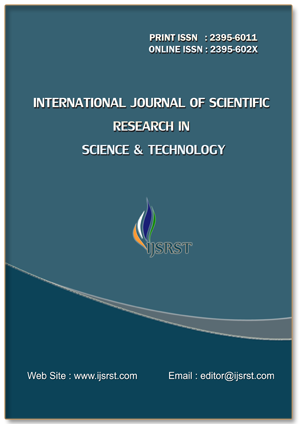Evaluation of the Effects of Pesticide Residual Levels in Selected Grains
DOI:
https://doi.org/10.32628/IJSRST24114132Keywords:
Maize, Cowpea, Groundnut, Residual Effect, Health ImplicationsAbstract
The use of pesticides to protect stored products is on the ascendency in the grain industry in Ghana. Grains (maize, cowpea and groundnuts) were procured, stored for three months and levels of pesticides residue determined. It was revealed that pesticides levels were still high among all the grains after the storage period of three months. Pesticides residue obtained were potentially harmful to humans when the grains are consumed. Levels of pirimiphos-Methyl and permethrin in maize were 48.71 and 19.39 respectively. In cowpea, pirimiphos-Methyl and permethrin levels were respectively 46.46 and 13.53 and in groundnuts, levels of pirimiphos-Methyl and permethrin were 47.50 and 19.64 respectively. All the identified chemicals exceeded their maximum residual limits in grains.
📊 Article Downloads
References
American Aktar, W., Sengupta, D. and Chowdhury, A. (2009). Impact of pesticides use in agriculture: their benefits and hazards. Interdicip Toxicol. 2(1): 1–12. DOI: https://doi.org/10.2478/v10102-009-0001-7
Alavanja, M.C.R. (2009). Pesticides Use and Exposure Extensive Worldwide. Rev Environ Health. 2009 Oct–Dec; 24(4): 303–309. DOI: https://doi.org/10.1515/REVEH.2009.24.4.303
Asare-Donkor, N. K., Kwaansa-Ansah, E.E., Opoku, F. & Adimado, A.A. (2015). Concentrations, hydrochemistry and risk evaluation of selected heavy metals along the Jimi River and its tributaries at Obuasi a mining enclave in Ghana Environmental Systems Research 4: 12 (2015). DOI: https://doi.org/10.1186/s40068-015-0037-y
Bart-Plange, A. Mohammed-Kamil, A. P., Addo, A and TEYE, E.(2012). Some Engineering Properties of Cashew Nut and Kernel Grown in Ghana. International Journal of Science and nature. Vol. 3(2) 2012: 406-415.
Boedeker, W., Watts, M., Clausing, P. and Marquez, E. (2020). The global distribution of acute unintentional pesticide poisoning: estimations based on a systematic review BMC Public Health 20:1875 DOI: https://doi.org/10.1186/s12889-020-09939-0
Ecobichon, D.J. (2001): Pesticide use in developing countries. Toxicology 160: 27–33. DOI: https://doi.org/10.1016/S0300-483X(00)00452-2
Ghana Standards Authority: Methods for Clinical Analysis; Methods for Sampling Cereals (As Grain)- Cereals and Pulses, Meat and Meat Products, 2019. (https://www.gsa.gov.gh)
Kosamu, I., Kaonga, C., and Utembe, W. (2020). A Critical Review of the Status of Pesticide Exposure Management in Malawi. Int J Environ Res Public Health. 2020 Sep; 17(18): 6727. DOI: https://doi.org/10.3390/ijerph17186727
Jayaraj, R., Megha, P. and Sreedev, P. (2009). Organochlorine pesticides, their toxic effects on living organisms and their fate in the environment. Interdiscip Toxicol. 2016 Dec; 9(3-4): 90–100. DOI: https://doi.org/10.1515/intox-2016-0012
Liu, Z.J., Liu, Z. B. (1999). The Status of the world agrochemicals. Chemial Technology Market, 22(12): 14-17.
Nicolopoulou-Stamati, P., Maipas, S., Kotampasi, C., Stamatis, P. and Hens, L. (2016). Chemical Pesticides and Human Health: The Urgent Need for a New Concept in Agriculture. Front Public Health. 2016; 4: 148. DOI: https://doi.org/10.3389/fpubh.2016.00148
Mohsenin, N. N. (1986). Physical Properties of Plant and Animal Materials, Gordon and Breach Science Publishers, New York.
Oesterlund, A. H., Thomsen.J.F., Sekimpi, D.K., Maziina, J.,Apio Racheal, A. and Jørs ,E. (2014). Pesticide knowledge, practice and attitude and how it affects the health of small-scale farmers in Uganda: a cross-sectional study Afr Health Sci. 2014 Jun; 14(2): 420–433. DOI: https://doi.org/10.4314/ahs.v14i2.19
Özkara, A., Akyıl, D. and Konuk, M. (2016). Pesticides, Environmental Pollution, and Health DOI: 10.5772/63094. DOI: https://doi.org/10.5772/63094
Pimentel, D. (1997). Techniques for Reducing Pesticide Use: Environmental and Economic Benefits. John Wiley and Sons, Chichester, USA
WHO.(2009) Recommended Classification of Pesticides by Hazard and Guidelines to Classification; Pesticides – toxicity, Pesticides – classification, Hazardous substances – classification, Guidelines; International Programme on Chemical Safety. (http://www.unece.org/trans/danger/publi/ghs/ghs_rev03/03files_e.html.)
Yang, C.C. & Deng, J.F. (2007). Intermediate syndrome following organophosphate.in5secticides poisoning. J. Chin. Med. Assoc., 70.,11., 467-72. DOI: https://doi.org/10.1016/S1726-4901(08)70043-1
Utyasheva, L. & Eddleston, M. (2021). Prevention of pesticide suicides and the right to life: The intersection of human rights and public health priorities. Journal of Human Rights 20:1, 52-71 DOI: https://doi.org/10.1080/14754835.2020.1850241
Zacharia, J. T. ( 2011). Identity, Physical and Chemical Properties of Pesticides, Pesticides in the Modern World - Trends in Pesticides. DOI: https://doi.org/10.5772/17513
Zikankuba, V.L. (2019)., Food and Drugs Authority (FDA), Ghana Standards Authority (GSA), food safety, pesticide residues, pesticide regulations and Maximum Residue Limits (MRLs), GAP: (https://www.tandfonline.com › doi › full › 23311932.2019.1601544). DOI: https://doi.org/10.1080/23311932.2019.1601544
Downloads
Published
Issue
Section
License
Copyright (c) 2024 International Journal of Scientific Research in Science and Technology

This work is licensed under a Creative Commons Attribution 4.0 International License.
https://creativecommons.org/licenses/by/4.0




